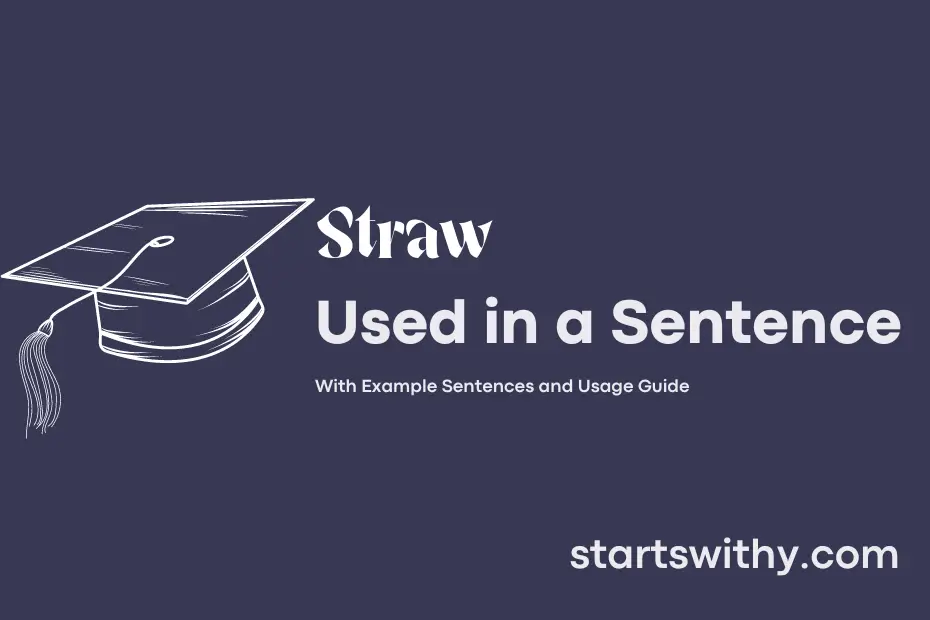Have you ever sipped a refreshing beverage through a slender, hollow tube? That simple yet ingenious device is what we commonly refer to as a straw. In its most basic form, a straw is a cylindrical tube made from materials like plastic, paper, or metal, designed to help us drink liquids more easily.
Straws come in various sizes, colors, and materials, serving as a convenient tool for enjoying drinks without the need to tip the container. This versatile implement has become a staple in restaurants, homes, and social gatherings worldwide, providing a hassle-free way to quench our thirst on the go.
7 Examples Of Straw Used In a Sentence For Kids
- The straw is long and thin.
- I use a straw to drink my juice.
- The straw is made of plastic.
- The straw helps me sip my milk.
- I like to blow bubbles in my straw.
- The straw is colorful and fun.
- I can bend the straw to make it funny.
14 Sentences with Straw Examples
- Don’t forget to bring a straw for your smoothie at the college cafeteria.
- I always carry a reusable straw in my bag to avoid using plastic ones.
- Can you pass me the straw so I can sip on my cold drink during the lecture?
- Let’s get some bubble tea after class and share a straw.
- The vendor gave me a paper straw with my sugarcane juice to promote sustainability.
- I accidentally spilled my juice because the straw had a hole in it.
- We used straws to blow bubbles during the chemistry experiment.
- I’m craving a milkshake with a thick straw to enjoy it fully.
- The college canteen stopped serving drinks with plastic straws to reduce waste.
- Let’s practice for the annual fest by playing the game of transferring peas with a straw.
- I prefer a metal straw for my iced coffee to keep it cold for longer.
- The straw I had for my drink was too short, and I struggled to reach the bottom.
- I recycle all my plastic straws in the dedicated bins on campus.
- The vendor offered a discount if we brought our own straws for the drinks.
How To Use Straw in Sentences?
To use the word “straw” in a sentence, think about how you can incorporate it to describe an object or an action. Here are some tips to help you get started:
-
Noun: A straw is a thin tube used for drinking beverages. For example, “I used a straw to sip my soda.”
-
Verb: As a verb, straw can be used to describe the act of spreading straw over an area. For example, “The farmer decided to straw the garden to protect the plants from the cold.”
-
Adjective: You can also use straw as an adjective to describe something as being straw-like in color or texture. For example, “She chose a straw hat to protect herself from the sun.”
-
Idiomatic expression: Finally, straw can be used in the idiomatic expression “the last straw,” meaning the final thing that causes a situation to become unbearable. For example, “His constant lateness was the last straw for her, and she decided to end the relationship.”
Remember to consider the context in which you are using the word straw to ensure that your sentence makes sense. With these tips in mind, you can confidently incorporate this word into your writing or conversation.
Conclusion
In conclusion, the various examples of sentences using the keyword “straw” illustrate its versatility as both a noun and a verb. From simple descriptions of objects like “the straw is yellow” to actions like “she strawed the garden”, the word “straw” can be used in a wide range of contexts. Whether referring to a drinking tool, a plant material, or an action of scattering, “straw” can convey different meanings based on its placement in a sentence.
Through these examples, it is evident that “straw” adds descriptive detail and action to sentences, making them more vivid and engaging. Its ability to be both a tangible object and a verb of action allows for creative expression and clarity in communication.



